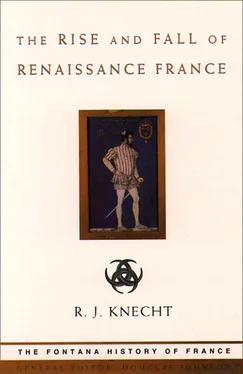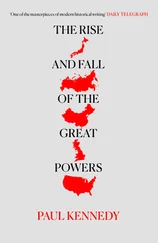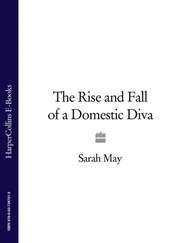In planning a crusade Charles was almost certainly influenced by a number of legends. One was that of Charlemagne, who had allegedly freed the Holy Places and handed them over to the emperor in Constantinople. Another was that of a king of France, called Philip ‘ le despourveu ’, who had travelled incognito to Naples in order to rescue the king of Sicily and his daughter from the Saracens. A prophecy popular in the 1490s forecast that a French prince called Charles, crowned at fourteen and married to Justice, would destroy Florence and be crowned in Rome after purging it of bad priests. He would then sail to Greece, become its king, defeat the Turks and end his life as king of Jerusalem.
Charles was also subject to less fanciful influences. There were Neapolitan exiles at his court, such as Antonello San Severino, who wanted his help to return to their native land. He gave them pensions and the use of a fortress in Burgundy until he could raise an army in support of their cause. Alongside the Neapolitans were Frenchmen, like Etienne de Vesc or Guillaume Briçonnet, who could see opportunities of personal enrichment or advancement arise out of a French intervention in Italy. Briçonnet was anxious to get a red hat. Even outside the court there was support for a French expedition south of the Alps. The bankers of Lyon and the merchants of Marseille wanted to expand their commercial interests in the Mediterranean at the expense of the Venetians and Aragonese.
Even within Italy there were forces working for a French intervention. Lodovico Sforza, nicknamed Il Moro, the effective ruler of the duchy of Milan, urged the king of France as early as 1491 to make good his claim to Naples. He suggested that Genoa might serve as a base for an attack on the southern kingdom. In January 1494 he was much alarmed when Alfonso, who had tried several times to have him assassinated, became king of Naples. His appeals to the king of France became desperate. Among Italian states, Florence was the only ally of the king of Naples, for the silk trade on which much of its prosperity depended passed through his territories, yet even there support for a French invasion existed. Many Florentines, who resented the autocratic ways of Piero de’ Medici, looked favourably towards France. For example, the Dominican preacher Savonarola prophesied Charles VIII’s coming in his Lenten sermon of 1493. ‘I have seen’, he exclaimed, ‘in the sky a suspended sword and I have heard these words: Ecce gladius Domini super terram cito et velociter. The sword fell bringing about wars, massacres and numberless ills.’ As for the Venetians, their foreign policy was primarily dictated by commercial interests: they wanted to maintain the status quo in the Adriatic and were, in general, opposed to any move which might antagonize the Turks. Yet they needed French help against the Habsburgs, who, having gained control of Trieste and Fiume, were entertaining maritime ambitions. Thus the Venetians were among the first to encourage Charles VIII to seize Naples. Another Italian who exerted similar pressure upon the king was Cardinal Giuliano della Rovere. He came to France shortly after his defeat in the papal conclave of 1492. Hoping to use a French invasion to topple his successful rival, Pope Alexander VI, he assured the French of the support of the Colonna faction which controlled the port of Ostia and several castles in the Roman Campagna.
Yet if Charles was under heavy pressure at home and abroad to invade Italy, support for such an enterprise among his own subjects was far from unanimous. According to a Florentine envoy it was opposed by the princes of the blood, most other nobles, royal councillors, prelates, finance ministers and all the people. Belgioioso, the Milanese ambassador, remarked: ‘It is truly a miracle that the king, young as he is, has persevered in his design in spite of all the opposition he has encountered.’ Charles himself informed the Italians in 1494 that he had left his kingdom ‘against the wishes of the princes and great nobles’. The opposition, however, was not united. Some great nobles resented the influence exercised by de Vesc and Briçonnet over the king. Louis d’Orléans wanted to divert the expedition from Naples to Milan, to which he had inherited a claim from his grandmother Valentina Visconti. The Bourbons showed no enthusiasm for the enterprise, yet took part in it. Nobles generally believed that the costs of equipping themselves for such a distant campaign would not be offset by the results. However, the main focus of opposition lay in the towns of northern France which refused royal demands for a subsidy. Many French people disapproved of the king leaving his kingdom when the Dauphin was still only an infant.
Commynes tells us that the French invasion of Italy in 1494 was poorly prepared. ‘All things necessary to so great an enterprise’, he writes, ‘were lacking.’ But Guillaume de La Mare, a usually reliable eyewitness, wrote on 27 March: ‘the Neapolitan campaign … is being prepared with the utmost prudence and zeal …There is nothing that the king is not putting into execution with extreme activity and care.’ Collecting the funds necessary to such a campaign was a matter of primary importance. Marshal d’Esquerdes informed Charles that he would need one million gold écus before the start of the campaign and another million once the army had crossed the Alps. The king managed to raise the first million by resorting to various expedients. The great nobles were asked for a loan of 50,000 ducats and contributions were also requested from the Chambre des comptes and other state departments. What the clergy offered is unknown, but a number of bonnes villes responded with varying generosity. Lyon offered 10,000 livres , while Paris refused to give anything. Amiens gave 3000 livres , half as much as the king had demanded. Parts of the royal domain were sold or mortgaged to the tune of 120,000 livres. The wages of royal officials and pensioners were delayed for six months. Finally, the taille was increased to 575,000 livres. As far as the second million was concerned, Charles relied mainly on contributions from various Italian cities.
On 13 February 1494, shortly after the death of Ferrante of Naples, Charles VIII travelled to Lyon and assumed the title of King of Sicily and Jerusalem. He dispatched an ambassador to the pope asking for the investiture of Naples, but on 18 April, at a secret consistory, Alexander conferred it on Ferrante’s son Alfonso. This volte-face by the pope, who had previously been hostile to Ferrante, did not cause the king to change his plans. On 29 July he reaffirmed his determination to go to Italy and appointed Pierre de Bourbon as lieutenant-general of the kingdom in his absence. Meanwhile, Charles assembled his army.
At the start of the summer of 1494 the king’s gendarmerie comprised slightly more than 1500 lances : that is to say, about 6000 to 8000 troops reinforced by the cavalry, archers and crossbowmen of the royal household. In addition there were some Italian lances , comprising fewer men than the French ones (one auxiliary and one page per man-at-arms). The infantry consisted of 4000 to 5000 men raised in France and about as many Swiss mercenaries. Thus it was an army of about 16,000 to 20,000 men which Charles led into Italy. To this number must be added the sizeable amount of non-combatants such as valets and pages, secretaries, merchants, camp followers and vagabonds in quest of loot. An important component of the French army was the artillery, which was larger and more advanced technically than any other and accounted for 8 per cent of the king’s total military expenditure. In 1489, Charles had about 150 pieces, dozens of gunners and large quantities of gunpowder. He was allegedly the first to use in Italy cannon balls made of iron instead of stone.
Читать дальше












